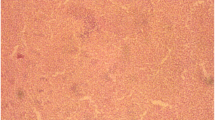Summary
A modification to the DNA extraction method “preferential lysis” (Gill et al. 1985) is proposed which can be applied to DNA mixtures of vaginal cells and spermatozoa. In mixtures with a low sperm content the further loss of sperm DNA caused by the extraction can be avoided by using “mild preferential lysis”. Amplification by PCR (polymerase chain reaction) then yields sufficient DNA to be able to identify both components in the mixture.
Zusammenfassung
Vorgestellt wird eine Modifikation der DNA-Extraktionsmethode “Preferentielle Lyse” (Gill et al. 1985) die üblicherweise bei Vorliegen von Vaginalzell/Sperma-Mischungen angewendet wird. Bei Mischungen mit nur geringem Spermienanteil sollen extraktionsbedingte Verluste von Sperma-DNA durch Anwendung einer “milden preferentiellen Lyse” vermieden werden. Der Nachweis erfolgte durch PCR-Amplifikation der extrahierten DNA-Proben.
Similar content being viewed by others
References
Brinkmann B, Rand S, Wiegand P (1991) Population and family data of RFLP's using selected single- and multi-locus systems. Int J Leg Med 104:81–86
Budowle B, Chakraborty R, Giusti AM, Eisenberg AJ, Allen RC (1991) Analysis of the variable number of tandem repeats locus D1S80 by the polymerase chain reaction followed by high resolution polyacrylamide gel electrophoresis. Am J Hum Genet 48:137–144
Gill P, Jeffreys AJ, Werrett DJ (1985) Forensic applications of DNA „fingerprints”. Nature 318:577–579
Horn GT, Richards B, Klinger KW (1989) Amplification of a highly polymorphic VNTR segment by the polymerase chain reaction. Nucleic Acids Res 17:2140
Kimes DR, Tahir MA (1985) An extraction procedure for seminal/ vaginal stains to eliminate streaking in the electrophoresis of phosphoglucomutase. Crime Laboratory Digest 12:32–33
Sambrook J, Fritsch EF, Maniatis T (1989) Molecular cloning. A new Laboratory Manual. Cold Spring Harbour Laboratory Press, Cold Spring Harbour New York
Wolff RK, Nakamura Y, White R (1988) Molecular characterization of a spontaneous generated new allele at a VNTR locus: no exchange of flanking DNA sequence. Genomics 3:347–351
Author information
Authors and Affiliations
Rights and permissions
About this article
Cite this article
Wiegand, P., Schürenkamp, M. & Schütte, U. DNA extraction from mixtures of body fluid using mild preferential lysis. Int J Leg Med 104, 359–360 (1992). https://doi.org/10.1007/BF01369558
Received:
Revised:
Issue Date:
DOI: https://doi.org/10.1007/BF01369558




